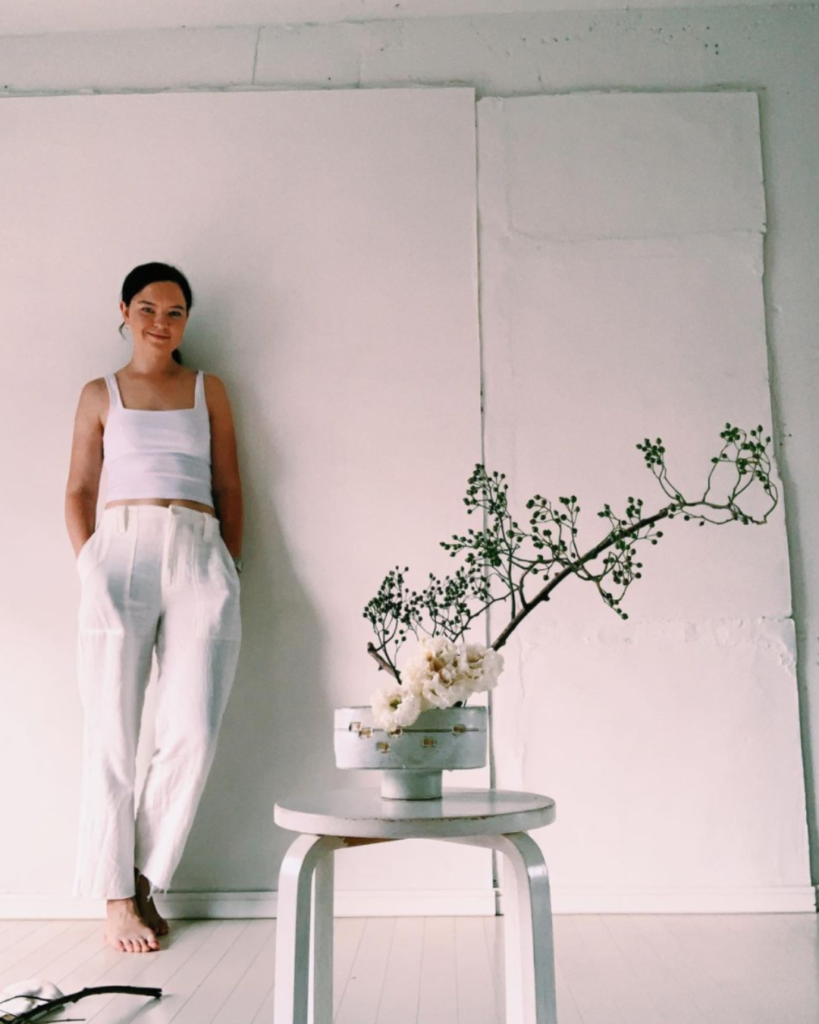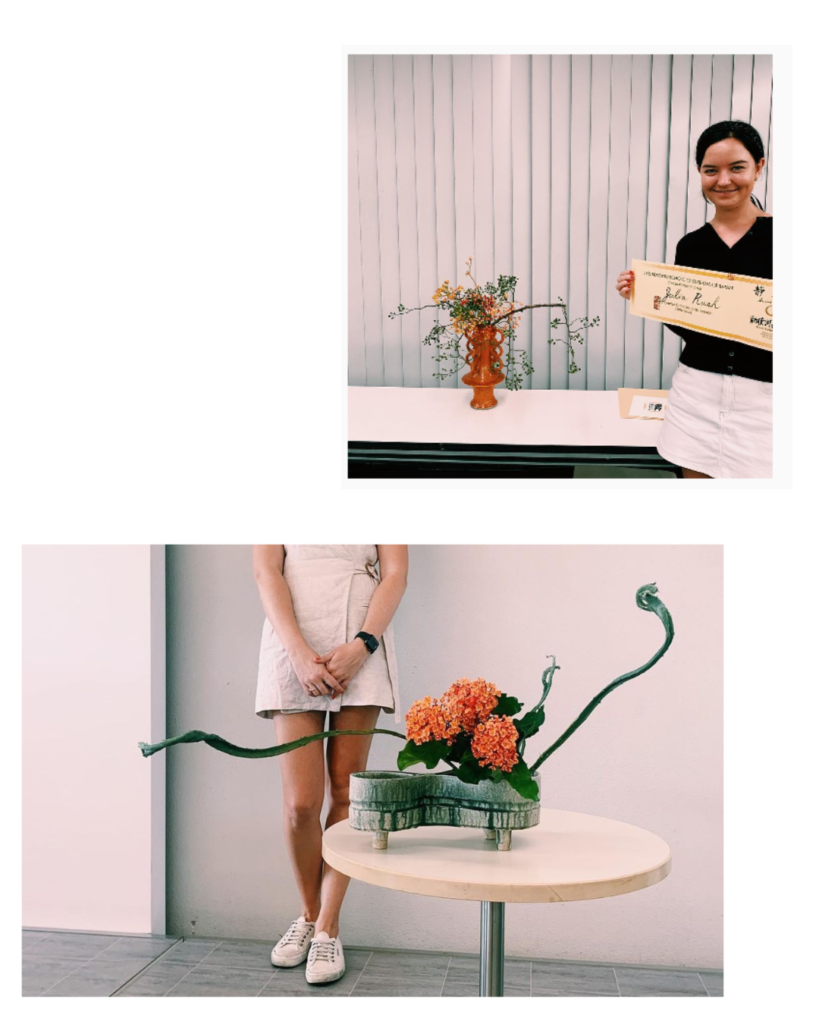
by Julia Rush
Ikebana teacher & student of over 10 years. Florist. Advertising Professional. Founder of Flower Club international. Contact via instagram @juliarushflowers.

I started ikebana not knowing that I was about to get into a life long learning program / long term relationship with flowers / the best thing that ever happened to me. One little book led me to one little workshop that led me to 5 textbook courses, a teaching certificate and hundreds of students around the world.
Since that first innocent workshop I’ve learnt alot along the way, and experienced a lot too. No joke – I even moved to Japan, got married and now have a half Japanese daughter. Needless to say Ikebana has led me down some unexpected paths. Who knows what your ikebana future has ready for you?
But along with all the incredible travel, friendships and life experiences that I’ve had since I got involved in the ikebana lifestyle, I’ve learnt a lot of things which I hope can help the beginners navigating the world of Ikebana. Here are my 9 top tips for beginners getting started with ikebana.
- Start with workshops
- Find a teacher you love
- Wax on wax off
- Build your portfolio
- Done is better than perfect and interesting is better than beautiful
- Transience transience transience
- Nature is your best inspiration
- Flower shopping 101
- Get out there and get involved
1. Start with workshops
There are more than 1000 types of ikebana schools with different styles around the world. The largest schools around the world are Sogetsu, Ikenobo and Ohara which have teachers all around the world and range in styles from traditional to modern and promote different philosophies. In your area you might have a local Ikebana group or association with teachers of various schools you can contact.
When you first begin your journey, I would recommend trying workshops or classes with a few different teachers from different schools to decide which teacher you’d like to continue studies with. Even once you’ve chosen a school it’s good to take extra workshops on the different styles of ikebana to get a new perspective and learn new techniques from time to time.
2. Find a teacher you love
When I first started Ikebana with my teacher I wasn’t aware there were different types of ikebana schools and I blindly began on the Sogetsu curriculum, but I wouldn’t change a thing as I loved the modern Sogetsu style and my sensei has been one of the most important people in my life.
Ikebana can be a huge commitment so it’s good to find someone you can connect with well and who will support you on your ikebana journey. I still continue classes with my original teacher, although online as we are in different countries. Most teachers are able to teach online or in person so you’re not limited to the teachers just in your area.
3. Wax on wax off
I compare ikebana to the training of a martial artist. When you begin your coursework, you have to go through the levels and you have to go through the basics. It’s the process of repetition that helps you build those skills where after time, you can create beautiful arrangements intuitively.
The beauty of the process is that you don’t need to worry about ‘having talent’ or ‘being a creative person’. When you continue to practice and follow the steps, eventually you build those talents and you become a creative person. It’s not about having some secret skill you are born with, it’s about practicing and training to develop those skills. And it takes time, but just trust in the process.
4. Build your portfolio
I cannot stress this point enough. From day one please take photos. Take photos of every single arrangement you make. Keep these photos and take the time to write down: the date, the materials, and your description. When you go back and look at your portfolio you can see your whole journey of your work. Your work is not supposed to look good in the beginning (although it possibly does). But it’s even better when you can look back at an arrangement years later and see all the imperfections in it that come from beginners work.
So much of ikebana is in the why and having your descriptions written down about your arrangements makes for such a nice memory when you come to look at it later. Your portfolio doesn’t need to be public, you can have a separate public portfolio, but it’s really rewarding to have a private portfolio that includes all your arrangements including (and especially) the imperfect.
5. Done is better than perfect and interesting is better than beautiful
Like anything you can spend 10 minutes or you can spend 10 hours building your creation. There are never ending limits to the ways that you can arrange your flowers and you can re-arrange and re-arrange for as long as you like. When you are getting started, I suggest limiting each arrangement to one hour maximum so you aren’t torturing yourself with what ifs. If you aren’t happy with it after one hour, take a photo, put it into the portfolio, write about what you weren’t happy about, and move on with your day or another arrangement.
Likewise don’t torture yourself with the question of if your arrangement is beautiful enough. Beauty isn’t necessarily the goal. In ikebana you are using your flower arrangement as a form of self expression, so rather than asking if it’s pretty enough, you should be thinking about what the message is you’re trying to convey. Think about your arrangement as a painting in an exhibition where they have the little explanation written next to painting about what the artist was trying to do. When you make your arrangement you should be writing a description about it, so that someone can say “oh that’s really interesting” after reading, rather than them saying “oh that’s a pretty flower arrangement”.
6. Transience, transience, transience
One of the great pleasures of ikebana arrangements is that you can make a thousand arrangements and unlike paintings or ceramics, you will never have to find a place to store them in your house. They will simply go back to the compost.
The pleasure of flower arranging is in the transience. Don’t get attached to an arrangement and desperately try to keep it going forever. When it’s lived its life, put it away and make a new one. You see so many people asking how long can I keep this arrangement alive for and wanting to drag out the length of it. But the beauty of flowers is that they are there just for a short time. Just like the cherry blossoms are so beautiful because of how short a time they are there for.
There’s no reason to put limits on yourself on how many arrangements you should make and how long they need to be displayed in the house. Make as many as you want, make a new one every day if you want. Just make sure you are being respectful of the plant material and putting them away carefully back into the garden or green waste as suitable.
7. Nature is your best inspiration
Colour combinations? Look at colours in nature. Plant material combinations? Look at what grows together. If you have a specific problem you are trying to solve, you can normally find the answer by taking a walk in nature.
8. Flower shopping 101
It’s not always easy trying to find ikebana-exciting materials in a regular florist. In ikebana we often are searching for branches or interesting accent materials which are easier to find in a garden than a shop.
The very best place to find your materials is in your garden, or a neighbours garden. So do your best to make friends with people who garden and most of the time they will genuinely be happy to give you their trimmings for free. Most people who like gardening are incredibly friendly.
Besides that, when you do your flower shopping I really don’t have a preference on where to buy flowers, except that with most things local seasonal products are normally the highest quality. But with ikebana you can and should be able to make wonderful arrangements with any flowers you have available. So don’t feel like you need to go to the fanciest florist in town for your materials. Although it is also a great pleasure, to buy your materials from fancy florist shops from time to time…
9. Get out there and get involved
Yes ikebana is of course great for mindfulness and inner peace and it’s great for developing your creative skills but the real fun of it is getting to meet new people who also love ikebana. Make sure you spend some time attending workshops or exhibitions with other ikebana fans, or making ikebana friends online through social media etc. You’ll end up meeting the most wonderful people from all walks of life in interesting places all around the world. That’s the real fun of it.
Please don’t hesitate to reach out to me via instagram @juliarushflowers if you ever need an ikebana friend or want some tips. I love to talk about ikebana.
